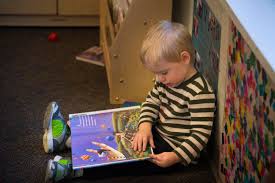First off:
No books related to movies, shows or toys: this means no Sesame Street, no Disney, no Barbie, no Bob the Builder, no Sponge Bob etc. If you are really ready for an amazing book center, get rid of all the teachy preachy ones too. These get removed immediately for trash or recycling.
Often we have questions about books that were books before they were movies: Clifford, Curious George, Madeline. This can be tricky. How old are the kids? Did they know it as a book first? Or has it always been product related for them? Is there a way for us to know?
When in doubt – run the book in question through the criteria here and see if it passes muster. Especially point #6.

Second:
No electronic books. These also get removed immediately for trash or recycling. Studies have shown that adults become overly focused on the buttons and sounds; the story and interactive banter of reading a book-book is lost.
Third:
After you have cleaned out and removed the above, you must remove all the books you have never read and put them in another pile. We will come back to them in a minute.
So at this point you should have 3 piles: 1) trash/recycle, 2) books you need to read and 3) books you are familiar with and have read.
Fourth:
You will be dealing with the third pile: books you have read and that you are familiar with. You need to go through each one looking for rips and tears.
Right out the gate, all books that are missing covers, missing pages, falling apart or are torn up beyond repair get added to the trash/recycle pile. No exceptions! I don’t care how much it cost, how much they love it, it’s MISSING PAGES! If they love it that much – go get another copy!!!!
Books needing minimal repairs get placed in the book hospital (we’ll come to this in a sec.). But they only leave the hospital with mends and repairs if they pass muster at point #6 and all other criteria listed here.
Start another pile for books that you are familiar with that are not ripped and torn. Jump to #6 to see if they make it back on the book shelf.
Fifth:
Time permitting, sit in a cozy chair and READ all of the books you had on the shelf that you have not yet read and are not familiar with. If you don’t have time, you need to make time until you put these back on the shelf. You have a responsibility to be familiar with all the books you are making available for the children. In the interim, locate books on site, or at the library that you are FAMILIAR with and add them to your book area BUT ONLY IF THEY MEET ALL THE CRITERIA LISTED HERE!!
Just because we found a book in the children’s section of the library, or because someone donated it, doesn’t mean it deserves place in your book area.
No books are permitted in the book area unless they pass the book audit!
Sixth:
At this point you are going to focus on the pile of books that are NOT related to any commercialized images, are NOT ripped, have ALL their pages and that you have read and are familiar with!
The final question is this… WOULD YOU READ IT TO ME?
Go through and look at the books, skim through them – is it relevant? Is it meaningful? Would you read it to your boyfriend? Your mom? Would you call me on the phone and read it to me? Does it make you say OMG! Lisa, you have to listen to this book??!?!?! And If not – I want you to consider why you’d consider reading it to the kids.
So, if you would NOT read it to me. If it’s not a “good book” – it goes in the trash/recycle pile and YOU need to take a trip to the library.
Seventh:
You now have a quality book center!!!! Good Work!
A few of comments about donating books:
- This usually gets people fired up but it’s my opinion and belief all the same. If I won’t provide it to the kids in the center – why should it be donated to other kids? The bottom line is crap is crap. If we have determined that it’s not fit for the kids here – how is it somehow ok for the kids there?
- And if I’m trying to spread the word the commercialized books are just that – commercials for shows and products – why would I give them to parents to read to the kids at home? We are sending seriously mixed messages when we do this.
- Do NOT be afraid to throw trash away! You are making room for books and stories that ALL children are entitled to!!
Source: Murphy, Lisa. “How to Do a BOOK CENTER Audit.” Ooey Gooey, Inc., 2012, www.ooeygooey.com/lisa-murphy%E2%80%99s-method-of-conducting-a-book-audit/.>
